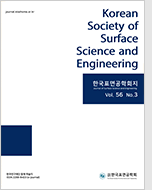
- Past Issues
- e-Submission
-

2021 Impact Factor 1.766
5-Year Impact Factor 1.674
Editorial Office
- +82-2-563-0935
- +82-2-558-2230
- submission@kssse.or.kr
- https://www.kssse.or.kr/

2021 Impact Factor 1.766
5-Year Impact Factor 1.674
The Korean Society of Surface Science and Engineering 2024;57(5):398-405. Published online: Nov, 5, 2024
DOI : https://doi.org/10.5695/JSSE.2024.57.5.398
In this study, ZnO nanoparticle treatments were applied to stainless steel 304 to mitigate the generation of stress corrosion cracking (SCC) under pressurized water reactor (PWR)-simulated conditions, focusing on temperature and pressure (300ºC, 150 bar), specifically simulating temperature and pressure. ZnO nanoparticles were synthesized via plasma discharge in an aqueous solution, with sizes ranging from 355 ± 142 nm to 25.7 ± 7.2 nm along the long axis, controlled by adjusting the voltage parameters. After treatment with 25 nm ZnO nanoparticle treatment, the surface of stainless steel 304 was analyzed using X-ray diffraction (XRD) and X-ray photoelectron spectroscopy (XPS), confirming the formation of a compact and dense ZnCr2O4 spinel oxide film with a thickness of approximately 65 nm. Corrosion potential tests conducted using a Potentiostat/Galvanostat revealed that corrosion resistance improved as ZnO nanoparticle size decreased. Additionally, U-bend tests under accelerated corrosion conditions showed significantly reduced SCC in samples treated with 25 nm ZnO nanoparticles. These findings suggest that ZnO nanoparticles synthesized via plasma discharge could be effectively applied for SCC mitigation in the nuclear industry.
Keywords ZnO nanoparticles; SCC; PWR-simulated conditions; Spinel structure